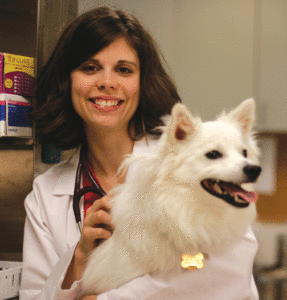-
Adopt
-
Veterinary Care
Services
Client Information
- What to Expect – Angell Boston
- Client Rights and Responsibilities
- Payments / Financial Assistance
- Pharmacy
- Client Policies
- Our Doctors
- Grief Support / Counseling
- Directions and Parking
- Helpful “How-to” Pet Care
Online Payments
Referrals
- Referral Forms/Contact
- Direct Connect
- Referring Veterinarian Portal
- Clinical Articles
- Partners in Care Newsletter
CE, Internships & Alumni Info
CE Seminar Schedule
Emergency: Boston
Emergency: Waltham
Poison Control Hotline
-
Programs & Resources
- Careers
-
Donate Now
 By Shawn Kearns, DVM, DACVIM
By Shawn Kearns, DVM, DACVIM
Angell Internal Medicine
617-541-5186
www.angell.org/internalmedicine
Chronic kidney disease (CKD) remains a prevalent finding in our animal patients, especially geriatric cats. CKD may be found in up to 31% of cats who are >15 years of age. The most common cause of chronic renal disease in cats is still considered to be chronic tubulointerstitial nephritis. Polycystic disease and nephro/ureteroliths are also seen as fairly frequent causes of CKD, while glomerular disease remains rare.
Disease confirmation is usually straightforward with documentation of blood work changes, poor urine concentrating ability and/or diagnostic imaging findings. For the most part, testing for earlier detection has been limited to procedures that are costly or limited to certain facilities. A recent study in the Journal of Veterinary Internal Medicine, however, did look at measurement of symmetric dimethylarginine (SDMA) as an earlier indicator of kidney dysfunction in cats. SDMA is filtered almost exclusively by the kidneys without reabsorption or secretion, essential characteristics for a renal function biomarker. The study indicated that SDMA levels increase before serum creatinine in cats that went on to develop CKD. Although more studies are needed, this may be useful in the future for earlier detection of CKD, which in turn, may allow for earlier interventions.
The International Renal Interest Society (IRIS) staging classification should be made based on at least 2 measurements in a fasted and well-hydrated patient. Urine protein:creatinine ratio and blood pressure evaluation are recommended for sub-staging. After a patient has been diagnosed and staged according to IRIS classification, a treatment plan should be developed that is appropriate for the patient, the owner’s ability and resources, and when possible, evidence based. Our main goals are to prevent and treat complications of the decreased kidney function, maintain adequate nutrition, slow the loss of kidney function and then direct any therapy at the primary kidney disease (e.g., treat for pyelonephritis if present).
 Studies have shown that dietary intervention in Stage II and Stage III IRIS CKD cats has a positive impact on survival. Further studies with SDMA may allow us to determine a benefit in the future with earlier stage disease. For now, however, the standard of care is to recommend a prescription, renal-based diet for cats with Stage II-IV renal disease. Given the finicky nature of many cats, it is recommended to transition sooner rather than later, and to introduce the new food over at least 2 weeks. It is acceptable to continue up to 10-15% of other foods if that will help them to eat the renal diets. Appetite stimulants may also aid in this transition. Some cats of course will not eat any of these diets, in which case, just maintaining their weight with other diets is recommended. Feeding tubes also can assist in maintaining adequate calories and allow use of the therapeutic diets when patients are not eating well. These are usually contraindicated in patients who have acutely decompensated due to anesthetic risks but can be useful in patients who are stable other than weight and decreased appetite.
Studies have shown that dietary intervention in Stage II and Stage III IRIS CKD cats has a positive impact on survival. Further studies with SDMA may allow us to determine a benefit in the future with earlier stage disease. For now, however, the standard of care is to recommend a prescription, renal-based diet for cats with Stage II-IV renal disease. Given the finicky nature of many cats, it is recommended to transition sooner rather than later, and to introduce the new food over at least 2 weeks. It is acceptable to continue up to 10-15% of other foods if that will help them to eat the renal diets. Appetite stimulants may also aid in this transition. Some cats of course will not eat any of these diets, in which case, just maintaining their weight with other diets is recommended. Feeding tubes also can assist in maintaining adequate calories and allow use of the therapeutic diets when patients are not eating well. These are usually contraindicated in patients who have acutely decompensated due to anesthetic risks but can be useful in patients who are stable other than weight and decreased appetite.
Although there is limited evidence-based medicine for the use of acid suppressors and anti-vomiting medications, these are often used with variable success at controlling clinical signs or maintaining appetite. Cerenia® ( maripotant citrate), a neurokinin receptor antagonist that works in the emetic center, although not labeled for use in cats, has been a useful addition for CKD cat.
There is also limited evidence-based literature for the use of subcutaneous fluids, however, these may allow for improved appetite in higher staged patients, help maintain hydration, and can reduce CKD-associated constipation. Water via a feeding tube would allow for electrolyte free water replacement, which is more ideal for the dysfunctional kidney to handle, but is not always practical.
Hypokalemia is present in about 20-30% of CKD cats in stage II and III. Low levels may be due to inadequate intake, increased urinary loss or enhanced activation of the renin-angiotensin-aldosterone system with salt restriction. Amlodipine may also be associated with hypokalemia. Unfortunately, besides the classic weakness signs seen with hypokalemia, persistently low levels may contribute to progressive renal injury and polyuria/polydipsia; therefore, correction is recommended when hypokalemia is noted.
Besides dietary therapies, control of phosphorous has the most evidence based rationale for treatment in CKD patients. Research has shown that in addition to phosphorous, other substances called phosphatonins, may play a role in the development of renal secondary hyperparathyroidism (SRHP). Fibroblast growth factor -23 (FGF-23) is one such phosphatonin that has been shown to be elevated prior to the increase in parathyroid hormone. Early in CKD, FGF-23 helps maintain phosphorous homeostasis and may prevent SRHP, but as phosphorous levels continue to elevate with declining renal function, so do the levels of FGF-23. The protective effect is lost and SRHP is further promoted. The veterinary literature indirectly supports that maintaining plasma phosphorous in the normal range (ideally low normal) improves survival and may prevent or reverse SRHP. It may also just improve how these patients feel clinically. Besides aluminum hydroxide liquid, one can consider compounded treats, capsules and powders to try to help facilitate administration. Lanthunum carbonate and sevelamer may be considered if aluminum hydroxide is not adequate though cost, formulation and dosing may be limiting factors for these products.
Over time, many CKD cats will develop an anemia related to impaired or absent erythropoietin production. Other causes of anemia should still be considered such as iatrogenic or spontaneous blood loss (intestinal ulcer), poor nutrition and reduced life span in the face of uremic blood toxins. Anemia can often contribute to low energy and poor appetite so again correction may help the overall quality of life of these patients. Darbepoetin alpha (Aranesp®) is now the recommended erythropoiesis-stimulating agent of choice. Although immune reactions may still occur, the incidence is much less common than with Epogen ® use. Generally therapy is considered when the hematocrit is around ≤20% though some clinicians will start earlier. Monitoring for improvement is recommended with weekly to biweekly blood work until the anemia has resolved. Most cats can be maintained on every other week injections after this
Hypertension may be present at any stage of renal disease so monitoring is recommended early in the course of disease. In Stage II –IV kidney disease, if the systolic blood pressure is > 160mmHg, treatment is recommended. If the blood pressure is > 180mmHg in a patient with Stage I disease, treatment should be considered. Blood pressure may be difficult to measure in some cats so watching trends in the urine protein: creatinine ratio may allow for an indirect assessment of blood pressure as the two are very closely related.
Chronic kidney disease remains common in our feline patient population. By making an appropriate treatment plan for our patients and correcting common consequences of the disease process we hope to continue to improve survival and their quality of life.
For more information, please contact Angell’s Internal Medicine service at 617-541-5186 or internalmedicine@angell.org.